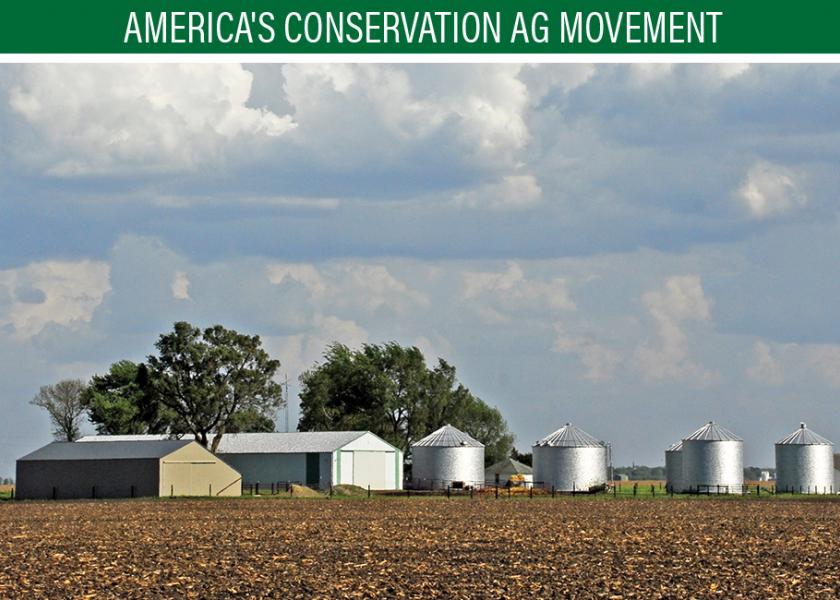Corteva Agriscience Sets Its Sights on 14 Sustainability Goals

Building trust in food begins with empowering farmers through one of the largest and most diverse conservation- and sustainability-focused public-private partnerships in our nation’s history: America’s Conservation Ag Movement. To find the latest news and resources related to the Movement, visit AgWeb.com/ACAM.
Barely six weeks into her new role at Corteva Agriscience, Anne Alonzo joined CEO James C. Collins, Jr. earlier this month to announce the company’s newly minted sustainability goals, 14 in all.
The goals span a wide range of initiatives and include improving soil health, nutrient and water management, crop yields, biodiversity, supply chain transparency and worker safety, among others. The target date of completion for all 14 is 2030, says Alonzo, senior vice president of external affairs and chief sustainability officer.
“I would underscore that these goals in their launch align with the purpose of the company,” she says. “And the purpose of the company is to enrich the lives of those who produce as well as those who consume, ensuring progress for generations to come. We want to improve livelihoods and operations while conserving resources and sustaining the land.”
Company officials spent much of the past year developing the goals and readying them for roll out on the eve of Corteva’s first anniversary as a company.
“It was a huge undertaking, involving nearly 100 of the company’s 20,000-plus employees in the formation process,” Alonzo says. “There was a lot of input and a lot of discussion about the goals and what we could do, and then benchmarking them with peers and leaders.”
Specifics for many of the goals have not been completely formalized, but some are slated to be detailed and implemented within the next 12 months.
First up is the company’s climate strategy plan, which is due June 1, 2021, according to Josiah McClellan, Corteva Agriscience sustainability leader.
“There are a number of exercises we have to go through in the next year to get a baseline of our own corporate greenhouse gas emissions, and then we’ll be able to make some climate commitments,” he explains.
After that, McClellan says Corteva will turn its focus to its sustainable innovation goal, which involves ensuring all new products going to market meet a specific set of standards by 2025.
“We have those criteria, we've published them, and we're getting the process underway, moving forward,” he says.
For the goals associated with nutrient stewardship, Alonzo says the company is using nitrogen use efficiency “because of its global relevance and the availability of historical data,” she explains. “For water stewardship, we're committed to reducing total water consumption while maintaining productivity on agricultural land and in our facilities.”
As part of Corteva’s commitments, the company will provide tools and training to farmers to help increase yield stability and agronomic stewardship practices.
“We’ll do that by working through our local, in-field framework,” Alonzo says.
“It's about what we can do at Corteva to make sure farmers have access to the technology and agronomic expertise that can help them achieve the sustainability and productivity outcomes they want without expecting them to do more,” McClellan adds.
Throughout the 10-year process, Alonzo says the company is committed to showing accountability and being transparent.
“We’re committed to providing our first report next year, to share what we’ve accomplished to date,” she says.
Here is an overview of the company’s 2030 sustainability goals:
Goals to benefit farmers:
1. Provide training for 25 million growers on soil health, nutrient and water stewardship, and productivity best practices.
2. Help increase the productivity, incomes, and sustainable farming practices of 500 million smallholder farmers cumulatively through 2030.
3. Design, validate and scale management systems that will enable farmers to sustainably increase crop yields by 20% compared to 2020 as a baseline, while simultaneously reducing greenhouse gas emissions by 20% within cropping systems compared to 2020.
Goals to benefit the land:
4. Improve soil health on 30 million hectares of global agricultural land by 2030.
5. Support water stewardship advances in global agricultural production by 2030: Help accelerate improvement in nitrogen use efficiency across global agricultural land by 2030; and reduce water consumption while helping to increasing yields on 2.5 million hectares of seed production and water stressed agricultural land by 2030 compared to 2020.
6. Enhance biodiversity on more than 10 million hectares of grazing lands and natural ecosystems globally through sustainable management practices and habitat conservation by 2030.
Goals to benefit communities:
7. Protect the safety of people at Corteva facilities and those working in agriculture.
8. Empower women, enable youth, and engage communities around the globe where Corteva Agriscience employees and customers live and work, by 2030.
9. Volunteer one million employee hours to support people and communities around the world by 2030.
10. Increase supply chain transparency from farmers to consumers, by leveraging digital tools that enable farmers to create additional value through transparency in agriculture markets, food systems, and communities.
Goals for the company’s operations:
11. Ensure every new product meets sustainability criteria by 2025.
12. Establish a climate strategy for scope 1, 2, and 3 emissions, including appropriate reduction targets by June 1, 2021.
13. Only use recyclable or reusable packaging by 2030.
14. Operate every site more sustainably through waste reduction, water conservation, and enhanced biodiversity.
Under Pressure: See How Development Threatens Farmland
Pork Producer Cuts Electricity Bill, Nitrates by More Than Half
Sustainability message as crucial as commitment







